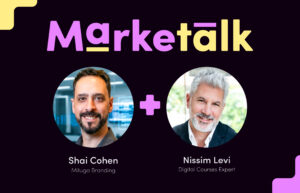What is the secret to successful design? How can we tailor our design to be SOM (Sales Oriented Marketing)? Is there a formula that ensures high results in every design? It’s not certain that this article will provide answers to all these questions. However, we will try to understand an important principle in design that both designers and clients of graphic designers can use in their next design.
We all know that good design catches the eye, attracts attention, and creates a rare moment where a potential customer stops and lingers on our design. Why is this moment so rare? Every day we are exposed to hundreds of advertisements, that’s the reality of living in these times, and this fact causes us not to linger on advertisements. Suddenly, low-level advertisements have entered the category of “things to ignore” and they fail to generate any response. This fact has led to the rise of graphic design as a profession that strategically operates on customers. Using a professional and smart process to convey business messages is much more necessary today than ever.
So, how do you create a design that catches the eye?
We’ve summarized several principles that form the basis of every sharp design that captures attention and generates business movement. Try to adhere to these principles in your next design:
- Visual
Advertising without an image or a similar visual element is like a pool without water. There’s nothing to do with it, and you can’t enjoy it. In every advertisement you initiate, it’s recommended to use some kind of image, and it’s worth following the other points to ensure the image is the right one. - Contrast
Another important principle is the principle of contrast. To capture the attention of the viewer, you must present an image that arouses the brain’s suspicion as if something special is happening. This principle is expressed in various situations, and one of them is contrast – Arcadi Duchin in a bank advertisement, the Jewish band in a supermarket advertisement, Lis Kids Opera in the best children’s car advertisement in the world. These are examples of contrasts that serve a business idea. Check for yourself – what contrast can you add to your advertisement to highlight it more? - Baby Vision
One of the most essential principles in design, yet often overlooked when it comes to our designs, is the child’s perspective. The principle is simple – just like a baby who gets excited about a toy 50 times and is still excited about it on the 49th time as he was on the first, so too we need to see the designs we create or those designers create for us. It’s easy to get used to a design we’ve seen before; the more we see it, the less it excites us. And if it doesn’t excite us, we won’t present it to our customers. Naturally.
If you want a winning design, view it each time as if it’s the first time you’re looking at it. This mindset will allow you to understand what’s really in hand and won’t lead you to despair over the design and produce a design based on incorrect considerations. Received a design? Close your eyes and tell yourself, “When I open my eyes, I’ll see this design as if I’m seeing it for the first time” – there you go, now look at a completely different design.
- Empathy
We’ve already talked about the visual principle that connects all your messages with a graphic image. But what should be in it? The customer. Why do you think celebrities receive advertising campaigns? Hint: It’s not because of their glamorous career in acting or singing, unfortunately. The reason is that those celebrities evoke identification among a certain audience (come on, really, Gidi Gov as a firefighter – does that seem reasonable? A grandfather to grandchildren, whose every economic decision affects the whole family for generations to come – that’s worth demeaning a cultural icon like Gidi Gov). When you design your design, and surely the visual figure must convey the message and evoke empathy and identification with the pain that your potential customer feels, that’s how you capture attention, and to make it work, invest everything to understand who your potential customer is. - Call to Action
Another significant part of message design is the clear and inviting integration of the call to action element. A design with a weak call to action functions like a weak marketing agent. Sometimes companies choose to hide this element for reasons of elegance, but it’s reasonable to assume that such a company is not looking for customers beneath the highlights; on the contrary, customers are seeking it out and want to enlist in its customer base (companies like Mercedes, for example). But in 99% of cases, that’s not the situation. For people to feel comfortable turning to you, they must see the call-to-action element quickly. It can be a large red button directing to a website or a phone number in a brilliant design – the important thing is that everyone who wants to do something about the matter will find the way to you easily through the design. The more difficult the design makes it, the less accessible it is, and therefore, the less attention it receives. - An Irresistible Proposal
Even if you meticulously follow all the previous tips in the article, skipping this tip might not yield good results despite professional efforts to create a design. Imagine a stunning and brand-new Land Rover image in the right corner (visual) with a large round sticker displaying the digits 888 prominently (contrast). Regardless of whether this offer is significantly more expensive than any other offer, what matters here is the composition, the integration of a luxury car image with a low price offer below what we all imagine – this is an offer that you can’t refuse, a dream car for only 888 NIS. We’ll stop for such an advertisement even if we’re very satisfied with our current car; that’s how advertisers make us make deals we don’t need; they create an irresistible composition, and at that moment, we buy. Maybe not physically, but mentally, we’re just buying at that moment and transitioning from a state of “What is this?” to a different question – “How do I get it?” Even if the offer for the Land Rover ends up being much more expensive, we’ve already bought it, and sales will start flowing, rest assured. Ask yourself, what offer can you propose in your business that is impossible to refuse? Free trial, free consultation meeting, and similar are not bad initial ideas, but remember, the bolder you are and the more you offer for the deal, the more responsive you can expect to be.
- Social Proof
After we’ve enriched the design with all the important principles, there’s still a small addition left, and the more you add it, the more you’ll increase the chances of success for the design and the business. Israelis don’t like to be fooled; they hate being the first suckers to be bitten by someone, and they’re not naive. This is an important fact to remember when selling something in Israel. To get someone interested in our design work, it’s worthwhile to make them understand that many have already gone the way before them. Show examples, provide recommendations, and send a portfolio – allow your customers to taste before deciding; it will reassure them. And the more powerful your social proof is, the more potential customers it will leave with you.
In summary, this article can be taken as a guide that leads you like readers of a technical specification to ensure that in design, we’ve retained all the elements that arouse the desire to stay with potential customers. An amazing example is the inclination of advertisers (and later politicians in a much less wise way) to use fake news. In fake news, there are several elements that an attention-grabbing ad contains – “Direct funding closes your deficit” (Really?) “Orbit protects against cavities” (Really?) Even the smiling cows on dairy products are fake news, reach the pasture and understand why. The use of fake news is important; it evokes empathy, it’s contrasting, and it has everything that attention-grabbing advertising needs (after all, there’s no such thing as negative advertising…). The thinking to use bold designs and creative thinking combined with a quality campaign creates advertising that stirs the market and achieves good results.
Good luck with advertising!




